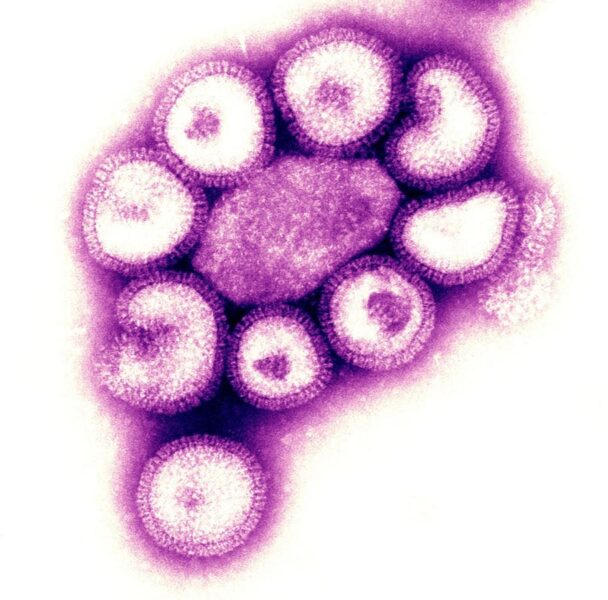Influenza Virus Colorized Tem, Negative Stained. Surface Glycoproteins Are Clearly Visible. (Photo By BSIP/UIG Via Getty Images)
Universal Images Group via Getty Images
A new mutated strain of the common flu, Influenza H3N2, subclade K, is spreading across the northern hemisphere, including the United States. This particular mutated strain of Influenza has gained dominance in many countries, including Japan, the U.K. and Canada.
In fact, Japan declared an influenza epidemic after experiencing a surge of flu infections. The U.K. has also experienced a wave of early flu infections. Although flu activity in the United States remains low, cases are on the rise and the dominant strain currently is Influenza A H3N2, according to the CDC. Here’s what to know about the H3N2 strain of the Influenza type A virus.
Influenza H3N2 Symptoms
Common symptoms associated with H3N2 are similar to all Influenza flu viruses and include fever, cough, runny nose, fatigue, muscle aches and chills. However, infection with this strain tends to be more severe across all age groups, particularly children and the elderly. Specifically, patients with H3N2 can experience higher fevers that can then lead to complications, such as difficulty breathing, dehydration and hospitalizations. This was a major concern during the last flu season that was dominated by H3N2 in 2016-2017.
Is The Mutated Subclade K Dominant In America?
Although the Influenza A H3N2 strain is currently causing the majority of cases in the United States, it is unclear if the subclade K is the culprit for the dominance of cases. This is because during the 44 day government shutdown, flu cases were not being tracked by the CDC, making it difficult to assess trends in the last several weeks. In addition, the CDC has not published data on specific subclades circulating in its latest FluView report. It is also unclear if the CDC will publish this type of data in the future.
The Subclade K was first identified in June in Europe, and has been spreading across the northern hemisphere since. This particular subclade has picked up seven mutations.
Will This Year’s Flu Shot Protect Against Subclade K?
The current 2025-2026 flu vaccine is a trivalent vaccine that offers protection against two Influenza A strains (H1N1 and H3N2) as well as one type of Influenza B strain. Although the vaccine offers protection against the H3N2 strain, it does not cover the mutated subclade K since the vaccine began formulation in February, well before subclade K came into the picture.
However, this does not mean that individuals should not get vaccinated. The purpose of vaccination is not to avoid infection all together, but rather to decrease the risk of severe illness, hospitalization and death. Since the vaccine offers protection against H3N2, getting the vaccine will offer some protection against subclade K, although it is not a perfect match against it. Data from the U.K. showed up to 75% protection for children against subclade K and up to 40% for adults when considering hospitalizations, according to NPR.
How Can You Stay Healthy Amid Flu Season?
There are several actions you can take to keep you and your loved ones healthy during the flu season, which typically peaks between December and February. The first is to get vaccinated with the flu shot. The CDC recommends everyone age 6 months and older to get the flu vaccine. In addition, avoiding crowded indoor areas where respiratory viruses can spread easily can be helpful. If necessary to go into those spaces, consider wearing a N95 or KN95 mask to decrease the chance of inhaling virus particles. Finally, washing hands regularly for 20 seconds and covering coughs and sneezes can go a long way in decreasing your chance of becoming infected with the flu.









